THE ECONOMY
Eritrea’s economy is based primarily on agriculture, light industry, fisheries and services, including tourism. Agriculture has for long provided the livelihood for the majority of the population, though it accounts for only a fifth of GDP and less than half its merchandise exports. But other sectors are rapidly growing, particularly marine-related activities and services, and agriculture itself is changing as a modern sector emerges.
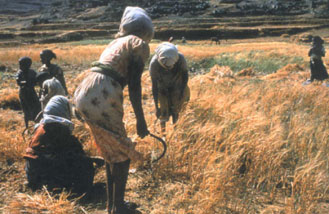 In the years following independence until the outbreak of the conflict with Ethiopia, Eritrea enjoyed an average annual growth rate of 7 percent, one of the highest in Africa. The new government pursued polices strategies and investments to promote rapid, widely-shared economic growth led by the private sector. It limited its own role mainly to create an enabling policy environment and investing in infrastructure and strategic industries that held little interest for the private sector
In the years following independence until the outbreak of the conflict with Ethiopia, Eritrea enjoyed an average annual growth rate of 7 percent, one of the highest in Africa. The new government pursued polices strategies and investments to promote rapid, widely-shared economic growth led by the private sector. It limited its own role mainly to create an enabling policy environment and investing in infrastructure and strategic industries that held little interest for the private sector
Overall economic policy is anchored in a commitment to free market-based, private sector-led, export oriented development as set forth in the government’s 1994 Macro-Policy Paper and reaffirmed in its 1998 National Economic Policy Framework and Program.
The main components are to:
* Improve agricultural production and productivity through the development of irrigated agriculture; and assist peasants, pastoralists and agro-pastoralists to enhance their productivity.
* Develop capital-and knowledge-intensive, export-oriented industries and services.
* Upgrade and improve the informal sector.
* Develop tourism.
* Create an international financial center.
* Develop an effective national public healthcare system.
* Provide a broad-based education system and improve access to it.
* Provide an effective social welfare and safety-net system.
* Safeguard and upgrade the environment.
* Decentralize and further democratize the political system.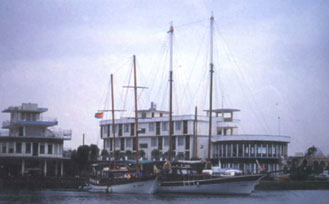
Transport and communication services were restored and expanded. Markets for labor, capital and products started functioning more efficiently. Broad-based fiscal, monetary and trade policy regimes aimed at maintaining macroeconomic stability, mobilizing government revenue and facilitating efficient allocation and utilization of resources were established. Private entrepreneurs responded by investing in services, construction and other industries, which led this early growth.
The outbreak, of war with Ethiopia in 1998-2000 brought progress to a temporary halt, damaging roads and bridges, power and telecommunications installations, schools and clinics, water supply and sanitation facilities, houses, factories, business and farms.
The war also created short-term losses in agricultural output and port revenues and declines in private sector activity and exports. The mobilization of 250,000 men and women and steep increases in military spending also helped depress the economy and drive up inflation. However, the disengagement of forces in 2001-02 set the stage for reconstruction and recovery.
With the onset of peace, the government focused on meeting immediate humanitarian needs, reconstructing infrastructure and assisting war-displaced people to resume normal economic activity, restoring a stable and supportive macroeconomic frame-work, demobilizing and reintegrating former a combatants, and continuing previously initiated development projects.
The government’s medium-term objectives for the opening decade of the 21st century are to develop new export markets, rebuild the port business, increase agricultural productivity, achieve macroeconomic stability, attract private sector investment, privatize the remaining state-owned business and develop a sound financial system.
FINANCE & BANKING
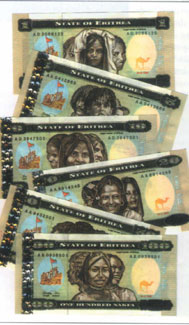 The Ministry of Finance sets and manages Eritrea’s fiscal policy. Its mission is to maximize government revenue, while effectively managing public expenditure, property, debt and investment. The Bank of Eritrea is the supervisory body for all financial institutions in Eritrea. It monitors the money supply and manages monetary policy.
The Ministry of Finance sets and manages Eritrea’s fiscal policy. Its mission is to maximize government revenue, while effectively managing public expenditure, property, debt and investment. The Bank of Eritrea is the supervisory body for all financial institutions in Eritrea. It monitors the money supply and manages monetary policy.
Within this framework, the Finance Ministry’s objectives are: to promote optimal allocation of resources across sectors, institutions, and regions; to promote an equitable distribution of income and wealth across the society; to enhance the competitiveness of Eritrea’s exports; to ensure adequate investment incentives for both domestic and foreign private capital; to promote domestic savings; to foster greater competitiveness in domestic markets; and to monitor tax revenue yield and strengthen tax administration.
The Bank of Eritrea issues, manages and retires currency; acts to influence money supply and credit availability, as well as interest and exchange rates; sets reserve requirements for and acts as lender of last resort to depository institutions; and performs other functions intended to promote overall financial sector development and efficiency.
Public Expendituree: In the decade since liberation, a tax structure that improves mobilization of revenues, promotes efficient use of resources, provides incentives to investors and achieves greater equity has been established. Taxes now apply to almost all sources of income and wealth. At the same time, personal and business income taxes have been simplified and streamlined, the number and level of customs duties have been reduced, and the sales tax structure has been greatly simplified.
To mitigate the cascading effects of taxation of intermediate inputs on the cost of domestic products, the tax rates applied on capital goods, intermediate inputs and raw materials have been reduced to a minimum. To promote competitiveness, domestic producers are given only modest effective protection, if any.
The tax collection rate reached just over 20 percent in 1997 but dropped to 16.5 percent in 2000 due to the effects of the conflict with Ethiopia. Moves to strengthen the Department of Inland Revenue are expected to yield collection rates of 18.4 percent in 2001 and 2002 and further improvements thereafter. To supplement tax revenue, the government will move to complete the privatization process underway since liberation. The remaining public properties will either be sold or shut down.
Public Expendituree:The principle challenge of expenditure policy in 2001-03 is to integrate the costs of emergency recovery and demobilization into a budget that is consistent with macroeconomic and poverty reduction objectives. This will entail a sharp reduction in defense outlays and containment of non-defense spending. The government’s goal is to reduce total expenditures from over 10 percent of GDP in 1999 and 2000 to 6.8 percent of GDP in 2002.
Monetary Policy: For the first six years after liberation, Eritrea was in a defacto currency union with Ethiopia, and the Ethiopian birr served as legal tender in Eritrea. However, as the fiscal, monetary, tax and investment policies of the two countries diverged, Eritrea decided to take full control of its own monetary policy.
On 8 November 1997, the Bank of Eritrea issued the country’s own national currency, the nakfa, whose value was determined primarily by the market. During its first 18 months as legal tender -until war broke out with Ethiopia -inflation remained at or below 2 percent.
The Bank of Eritrea will use its monetary policy instruments to hold nonfood inflation at modest rates. Expansion of the monetary base will be limited by curtailing credit to the government, as per the Bank’s basic guidelines.
Financial institutions:Eritrea follows a policy of universal banking any bank can go into any business, so long as it acts responsibly and meets national banking guidelines. Three banks, each head quartered in Asmara but with branches around the country, fulfill Eritrea’s main financial management needs.
The state-owned Commercial Bank of Eritrea specializes in general commerce and consumer services. The Development and Investment Bank of Eritrea, also owned by the government, concentrates on long-term loans for development projects. The Housing and Commerce Bank of Eritrea focuses on real estate and housing-related transactions. In terms of deposits, one of these “the Commercial Bank- controls over 90 percent of the market.”
The state-owned National Insurance Company of Eritrea is the country’s only national insurer. It provides full insurance services: fire, motor, marine, workmen’s compensation, public liability, burglary, life, money, fidelity guarantee, bond, aviation, accident, investment, and trade credit, among others.
Privately operated foreign exchange bureaus made their appearance in Eritrea in 1997, with the launch of the national currency. Fourteen were operating in Asmara, Massawa and Assab by 2001. A new privately-capitalized general services bank, the Awgaro Bank of Eritrea, is due to open in 2002. Others are expected to follow.
INFRASTRUCTURE
At the time of independence, Eritrea’s infrastructure lay in ruins. It had been badly destroyed by the long war and neglected for decades by the occupying power. Since then the roads connecting the major towns and cities have been repaired and improved, the seaports have been substantially rehabilitated, airports have been expanded, and work on the railway has resumed operations, but much more remains to be done.
Roads & Bridges:At independence Eritrea had one of the lowest levels of road density in the world. The first priority after liberation was the reconstruction of the Asmara-Massawa road, over which most of Eritrea’s imports travel to reach the interior. Other early projects included improving asphalt roads linking Asmara with Keren, Dekamare, and Zalembassa, as well as upgrading the Dekamare “Senafe, Keren-Barentu, and the Nefasit-Dekamare highways.”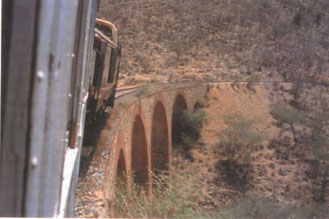
Major improvements were also achieved in the construction of all weather unpaved roads linking Keren and Afabet, Dekamare and Tserona, Mendefera and Barentu, Barentu and Tessenei, and Tessenei and Om Hajr, among others, while numerous feeder roads were constructed to join agricultural areas to towns and cities. Major new projects include the completion of a 600-kilometer all-weather asphalt road between Massawa and Assab.
Bailey Bridge technology was introduced in Eritrea in 1998, when the need arose for the reliable structures to replace those damaged in the war with Ethiopia. Bailey Bridges were constructed over the Gash River near Awgaro and near Kuluku and in Tessenei. Other bridges were built over the Mereb River near Ghiniseba and over the Barka River near Kerkebet.
Though most Eritreans still travel by foot or by animal, an increasing number go on wheels. Despite the limitations of the road system, vehicle traffic has soared since liberation. The vehicle fleet grew from 8,669 in 1991 to nearly 40,000 by 2000. Registered buses increased during the same period from 267 to 1,562.
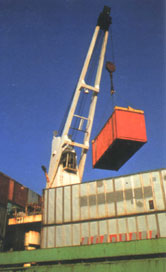 Railways: The reconstruction of the narrow-gauge railway that links the port of Massawa with Asmara is emblematic of Eritrea’s determination to control its own destiny and chart the course of future development.
Railways: The reconstruction of the narrow-gauge railway that links the port of Massawa with Asmara is emblematic of Eritrea’s determination to control its own destiny and chart the course of future development.
The railroad was started by the Italians in 1887 and finished in 1932. At its peak, it crossed the coastal plains and traversed the shoulders of the plateau up to Asmara, plunging in and out of long tunnels and clinging tightly to the edge of the steep escarpment before reaching the capital and rolling west to the Barka lowlands in Agordat. It stopped functioning in 1975 during the liberation war, when Ethiopian forces tore up its iron rails to build fortifications and abandoned its rolling stock.
After independence, a proposal by foreign consultants to refurbish the railway for US$400 million was rejected. Instead, aging railroad workers, many in their 80s, were invited to come out of retirement to rebuild it, which they soon set out to do. Service between Massawa and Ghinda resumed in 1996. The 117-kilometer line to Asmara is currently on the way toward completion.
Civil aviation: The Asmara International Airport has been substantially upgraded since liberation with the installation of new communications and lighting systems, the addition of state-of-the-art navigational aids, the reconstruction and expansion of the main terminal, the construction of new cargo warehouse and the establishment of new meteorological units.
In 1996, construction started on a new full-service international airport in Massawa to serve export processing needs and the expanding tourist trade on completion in 2002. In the port of Assab, the terminal was expanded. Improvements were made on many of the smaller regional airfields that service urban centers in the interior, one of which at Sawa in Gash-Barka-was upgraded to international status to facilitate the export of fresh produce and livestock from the western lowlands.
Marine Transport:The ports at Massawa and Assab were thoroughly rehabilitated after liberation and are undergoing continuing improvement and expansion. New storage sheds were constructed and new equipment was procured, including tugboats, pilot boats, mobile cranes, and bagging machines.
Though shipping traffic in Assab plunged when war broke out with Ethiopia, it showed steady gains in Massawa throughout the decade. Cargo handled there more than doubled from 1991 to 2000, reaching more than 1 million tons. The number of ships handled there rose in the same period from 104 to 284. The acquisition of mobile cranes in both ports also facilitated the expansion of container handling.
Work on modernizing both ports continues. Projects slated for completion in 2002 include extending the berths, dredging the harbor, reclaiming coastal land, constructing new container terminals, improving drainage and sewerage, and building new workshops, warehouses and equipment sheds.
Housing & urban planning:With independence, the Housing Commission was charged with returning previously nationalized houses to their original owners and developing a nationwide system of titling and registration. In the first ten years, the commission received nearly 177,000 applications in seventeen towns and resolved all but 2,467.
During the same period, the Ministry of Public Works drew up master plans for most major Eritrean towns. These include Segeneiti, Senafe, Dekamare, Adi Keih, Dibaruwa, Mendefera, Tessenei, Agordat, Keren, Barentu, Afabet, Nakfa, Massawa, Mai Atal, Ghinda and Assab.
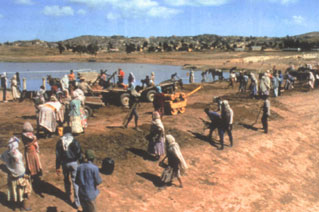 Water resources:In 2001, the World Bank estimated that 63 percent of urban residents and 42 percent of rural dwellers had access to safe drinking water in Eritrea. To increase coverage, the government is investing in new drinking water projects throughout the country. The need for this becomes especially acute in the dry season when up to one-third of Eritrea’s water sources dry up.
Water resources:In 2001, the World Bank estimated that 63 percent of urban residents and 42 percent of rural dwellers had access to safe drinking water in Eritrea. To increase coverage, the government is investing in new drinking water projects throughout the country. The need for this becomes especially acute in the dry season when up to one-third of Eritrea’s water sources dry up.
In the decade since liberation, the Water Resource Department constructed 600 new rural wells and helped set up 243 village water committees to manage scarce local supply. A new reservoir was constructed at Tokker, north of Asmara, to meet the capital’s water needs, and services were substantially improved in Keren, Massawa and other towns. In 2002, the government will undertake a comprehensive assessment that will form the basis of a national water resources development plan.
Egypt (1846- 85): In 1846, Mohammed Ali’s forces took control of Ottoman Habesh and enlarged it by annexing adjacent independently-ruled Eritrean regions in Bogos and Danakil. Egyptian forces also expanded into western Eritrea from the Sudanese town of Kassala, though they suffered major losses when they tried to drive further inland. After Egyptian rule was toppled in Sudan during the Mahdist uprising of 1888, Cairo’s authority in Eritrea collapsed.
Communications:Eritrea has underdeveloped but rapidly improving telecommunications and postal services. While cities are connected to one another and to the rest of the world, smaller towns and rural villages often lack services. To remedy this, the government plans to privatize the telecommunications network and attract foreign investment to upgrade it. Meanwhile, it has been working to expand, extend and modernize the infrastructure inherited at liberation.
Among the early challenges were installing new switching capacity, digitalizing major urban exchanges, establishing new satellite links, laying new cable networks and more. The number of phone lines increased from only 13,000 in 1992 to more than 30,000 by 2000. The first mobile telephone company became operational in 2002. Demand is expected to reach 200,000 over the next five years.
Eritrea established direct access to the internet in 2000, though email service had been available since 1996. A year after going online, there were four internet service providers with approximately 1,500 subscribers, but the numbers were growing daily as new cyber-cafes opened across Asmara and in other towns. In the future, Eritrea plans to join an Africa-wide initiative to provide fast, low-cost internet service over fiber-optic cable. New programs will include paging, enhanced data communications services, TV distribution, the Global Mobile Personal communications System (GMPCS) and others.
Eritrean Postal Services began rudimentary operations in 1991, shortly after the liberation war ended. Since then, postal units have more than quadrupled, service to rural areas has substantially expanded and a new express Eritrea Speed Post was added, along with other new products and services. During this decade, the volume of local and international mail has grown by a factor of more than ten, as Eritreans reconnected with one another and with the rest of the world.
AGRICULTURE
Agriculture, animal herding and fishing remain the primary source of income and food for the majority of the population, though agriculture accounted for only 16 percent of Eritrea’s GDP and 20-30 percent of its merchandise exports in the year 2000. Staples comprise about 42 percent of annual agricultural production, while cash crops make up 28 percent and livestock and fisheries account for the rest.
Most staple cereal farming has historically been done in the central highlands. Today, however, it is developing rapidly in the coastal plains and the western lowlands where irrigated agriculture is increasingly widespread.
Eritrean farmers traditionally cultivate grains, legumes, fruits and vegetables and raise goats, cattle, sheep, camels, pigs, donkeys and horses. Most operate at a subsistence level, consuming most of what they produce and selling only a small surplus in local markets.
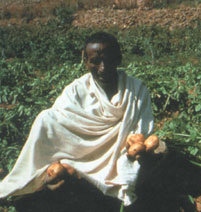 In most areas, farming and animal husbandry are based on traditional techniques, where farmers use animal drawn implements to till the land. Moreover, Eritrean farmers are exposed to unpredictable weather conditions and wide seasonal fluctuations in input and product prices, which make farming a perennially risky enterprise.
In most areas, farming and animal husbandry are based on traditional techniques, where farmers use animal drawn implements to till the land. Moreover, Eritrean farmers are exposed to unpredictable weather conditions and wide seasonal fluctuations in input and product prices, which make farming a perennially risky enterprise.
Under these conditions, the government is pursuing a three-pronged strategy to increase agricultural output: increasing land under cultivation, raising productivity, and encouraging the production of higher-value crops for export and domestic consumption.
Eritrea has 1.6 million hectares of land suitable for rain fed or irrigated cultivation that are not now being farmed. The government is encouraging settled and development by opening new lands for farming and providing infrastructure, essential services, access to credit and farm inputs, and secure tenure rights to individuals and groups.
The government is also taking steps to increase the productivity of land, labour and capital. It has decontrolled prices of agricultural inputs, reoriented agricultural research toward the problems and needs of small-holders, developed and expanded extension program, decentralized responsibility for program development and management, and transferred most of its commercial activities to the private sector.
At the same time, the Ministry of Agriculture is encouraging small-holder farmers to produce high-value crops and livestock for export, such as flowers for Europe and sheep and goats for Middle East markets. Horticultural products with great potential include cotton, oil seeds, cut flowers and some fruits and vegetables.
The strategy for increasing livestock production is to raise the productivity of herds by enhancing rangeland and water resources management, promoting superior animal breeding systems, improving animal health and nutrition, and developing higher quality animal feed and fodder systems. Efforts are also underway to expand marketing outlets and encourage the use of refrigerated transport services, particularly in the expanding dairy industry.
One of the top priorities is to increase the country’s forest and water resources and to improve the quality of soil. To meet these objectives, the Ministry of Agriculture is undertaking and accelerated aforestations program in which communities establish self managed woodlots. Participants in the annual Summer Work Program also build terrace, plant trees and undertake soil and water conservation works throughout the country. With more than 50 forest nurseries functioning across the country, the Ministry plans to distribute more than 40 million tree seedlings by 2004.
FISHERIES
Fishing is one of the most underdeveloped sectors of the Eritrean economy and potentially one of the most lucrative. The Red Sea is home to more than 1,000 species of fish, including tuna, red snapper, kingfish, sardines and other prime food fish, and over 220 species of coral. There are also large stocks of high-value species, such as lobster, crab, oyster, and shrimp.
Fish consumption is relatively low in Eritrea, apart from Asmara and coastal areas, as Eritreans are traditionally meat-eaters. However, efforts to promote fish consumption through the schools and the national media are introducing more and more people to the practice. Improved refrigeration and transport capacity makes this more viable, though most fish caught and processed in Eritrea is still set aside for export.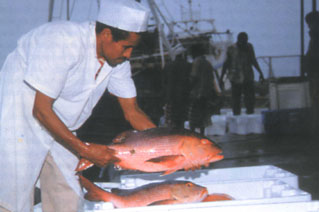
Eritrea has exclusive rights to almost 52,000 square kilometers of largely unexploited waters and is moving rapidly both to develop and to protect its extensive marine resources. From 1997 to 2000, the volume of fish landed in Eritrean waters shot up from 780 tons to more than 10,000.
In 1998, a joint venture of the government with European investors established a modern fish-processing plant in Massawa at a cost of US$1.2 million. By 2000, Eri-fish, was exporting frozen fish to markets in Europe. By 2002, new ice plants were added, with a combined production capacity of more than 150 tons of ice per day.
In 1999, Eritrea embarked on one of the most innovative, commercial aquaculture ventures in the world-Seawater Farms Eritrea. A joint undertaking with a U.S. firm, the project uses untreated seawater instead of fresh water to produce shrimp and fish, together with salicornia, a salt-tolerant crop that can be eaten as a vegetable while young. The mature plant also yields a high-protein edible oil and material for fuel briquettes, particle board and animal fodder. The first large-scale shrimp shipments to Europe started in 2001.
In addition to generating income, the new farm enhances the environment by expanding wetland areas to filter the irrigation water by planting new mangrove forests along the seashore, and by providing a refuge for rare and endangered wildlife. Plans are underway to construct research facilities, a visitor’s center, a first-class hotel and other accommodations to promote learning and eco-tourism.
Farther south, on Haleb Island off the Assab coast is the Harena Boatyard, a joint venture with an Australian company that is producing high-quality fiberglass boats for fishing and other purposes.
TRADE & INDUSTRY
Industry and manufacturing have a long history in Eritrea. By the mid 1970s, the colony was exporting goods worth US$ 100 million a year. However, this sector declined rapidly following Ethiopia’s move to nationalize most industrial operations in 1975.
The industries that Eritrea inherited were small-scale, based on obsolete technologies and processes and unable to provide goods and services competitively. Due to inadequate technological input, lack of supplies and raw materials and poor and politicized management, the manufacturing and service enterprises were operating at 20-50 percent capacity.
Like the rest of the economy, Eritrea’s once promising export sector was crippled while under Ethiopian control. Exports were limited to basic commodities and consumer products that did not generate foreign exchange needed to import machinery, equipment and production inputs.
Nevertheless, Eritrea’s strategic location and its highly motivated and enterprising workforce provide opportunities to develop a competitive manufacturing sector producing goods for export and domestic consumption. The number of such enterprises rose from 645 in 1991 to more than 1,900 in 1999, with and active workforce of more than 20,000. Further growth potential is strongest in textile and garments, leather goods, processed foods, fabricated metals, plastics, construction materials and other resource based goods.
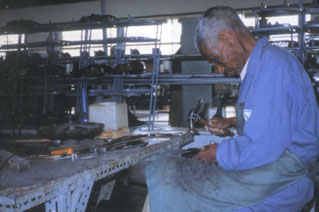 Because the private sector had only limited capacity to invest and lead economic recovery in the first years after independence, the government initially acted to catalyze investments in strategic sectors and to establish the legal, social and institutional framework for both immediate recovery and long-term development. Within a decade, however, 35 of the 39 major state owned enterprises were privatized, with the others in the process of divestiture.
Because the private sector had only limited capacity to invest and lead economic recovery in the first years after independence, the government initially acted to catalyze investments in strategic sectors and to establish the legal, social and institutional framework for both immediate recovery and long-term development. Within a decade, however, 35 of the 39 major state owned enterprises were privatized, with the others in the process of divestiture.
The economy has been fully open to private participation since 1994, when the government issued basic investment and macro-policy documents. The government views foreign investment and collaboration as an important means to supplement the country’s limited supply of production technology, capital and management and marketing skills. Therefore, foreign investment is encouraged in all sectors without restrictions related to ownership or capital structure.
Foreign investors are treated the same as domestic investors in obtaining access to land, utilities and other production inputs. There are no exchange controls limiting foreign investors from repatriating their profits and capital gains through the domestic foreign exchange market. Foreign investors are allowed to bring in needed capital and production inputs upon payment of a minimal customs duty. Employment of expatriate staff whose skills are in short supply in the Eritrean market is also allowed, with clearance from the relevant authorities.
Trade: To encourage rapid expansion of trade and free mobility of capital, the government has eliminated or substantially reduced trade barriers. Nearly all quantitative restrictions and prohibitions on imports have been eliminated. The import tariff structure has been rationalized by narrowing tariff bands and reducing rates. The customs administration has been streamlined, and all taxes on exports have been eliminated.
Eritrea’s main exports are salt, hides and skins, textiles, processed food, and small manufactures. The main trading partner prior to the outbreak of war in 1998 was Ethiopia. Other trading partners include Sudan, Saudi Arabia, Italy, United Arab Emirates, Germany, the U.S., and Yemen.
Business licensing: To facilitate increased direct investment, the government established a one-stop Business Licensing Office in 1995 where all necessary paperwork can be transacted in a timely, transparent and uncomplicated process. Headquartered in Asmara, the office has branches in Assab, Massawa, Nakfa, Keren, Agordat, Barentu, Adi Keih, Dekamare and Mendefera. In its first five years of operation the office issued more than 20, 000 licenses for business ranging from import/export to manufacturing, transport and construction.
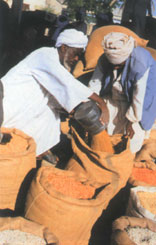 The Grain Board: The Eritrean Grain Board was created in 1993, in the aftermath of nearly a decade of severe food shortages, to organize grain storage facilities for use in emergency situations. The EGB has stores in Dekamare, Zgb, Tessenei and Asmara with a combined capacity of 95,000 tons. After war broke out with Ethiopia in 1998, severely disrupting that year’s harvest, the EGB distributed 300, 000 tons of grain to displaced Eritreans, largely through the Eritrean Relief and Refuge Commission, ERREC. The EGB also acts to stabilize grain prices when market fluctuations threaten farmers with short-term losses.
The Grain Board: The Eritrean Grain Board was created in 1993, in the aftermath of nearly a decade of severe food shortages, to organize grain storage facilities for use in emergency situations. The EGB has stores in Dekamare, Zgb, Tessenei and Asmara with a combined capacity of 95,000 tons. After war broke out with Ethiopia in 1998, severely disrupting that year’s harvest, the EGB distributed 300, 000 tons of grain to displaced Eritreans, largely through the Eritrean Relief and Refuge Commission, ERREC. The EGB also acts to stabilize grain prices when market fluctuations threaten farmers with short-term losses.
Maintaining standards:The Eritrean Standards Institute, established in 1995, prepared basic standards to be applied to products across all economic sectors, gives standard marks to key products (the national flag, salt, cereal grains, edible oils, unprocessed leather, cement and many others). It also tests measures used in trade for accuracy and consistency. More than 400 such standards had been set by 2000.
ENERGY & MINING
At the start of the 21st century, Eritrea’s annual per capita energy consumption ranked among the lowest in the world. The main source is biomass, which is non-renewable and in rapidly declining supply. Imported petroleum used mainly as fuel for transportation, electricity generation and industrial production-accounts for most of the rest.
Given the dwindling biomass resources and the scarcity of foreign exchanges for importing petroleum products, Eritrea’s current pattern of energy consumption is unsustainable. Furthermore, burning biomass in open hearths and stoves uses energy resources inefficiently and pollutes indoor air, causing respiratory disease. Under these circumstances, the government has made top priorities of increasing energy efficiency, promoting energy conservation, and encouraging development of new energy sources.
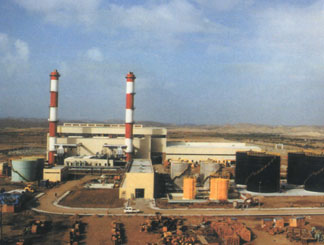 Biomass: Firewood, charcoal, animal dung and crop residues have long been Eritrea’s most important energy sources, accounting today for three-fourths of energy consumption in the country as a whole and as much as 96 percent of that used by individual households. Firewood alone represents 70 percent of the total.
Biomass: Firewood, charcoal, animal dung and crop residues have long been Eritrea’s most important energy sources, accounting today for three-fourths of energy consumption in the country as a whole and as much as 96 percent of that used by individual households. Firewood alone represents 70 percent of the total.
Electricity: A new generating plant at Hirgigo, on the Red Sea coast, will more than double Eritrea’s total electricity production from 52 megawatts to 136 megawatts once it is completed in 2002. Electricity transmission and distribution systems are also being expanded and upgraded, while power grids in major consumption centers (Asmara, Massawa, Keren, Dekamare, Mendefera) have been interconnected.
Major efforts are also underway to bring power supplies to rural areas to improve access to services and facilitate the establishment of non-farm business. To keep costs affordable to rural villagers, electricity will be supplied from the national grid using low-cost technologies and operational producers that can be upgraded as demand grows. Where appropriate, stand-alone generators are being introduced. For remote villages, approaches using renewable energy are being piloted. All rural electrification projects will operate on a cost-recovery basis once the systems are built, though the government will subsidize construction where services are not otherwise viable.
Alternative energy sources:
Solar and wind power generating capacity is being expanded throughout Eritrea, particularly for the use by schools and clinics in remote areas, and the potential use of hydro and biogas energy is being explored. Studies by the US Geological Survey indicate that the potential for developing thermal energy is also significant.
Mining: Geological data indicate that Eritrea contains significant deposits of gold, base metals, ferromanganese and industrial and construction materials such as granite, marble and limestone. Marble is of high quality and suitable for export to the Middle East and Europe. Commercially recoverable deposits of oil and natural gas along the Red Sea coast may be substantial.
Eritrea’s mining sector development strategy is focused on promoting domestic and foreign direct investment in prospecting, exploring and development. To facilitate this, the Ministry of Energy and Mines has conducted geological surveys of promising sites and indicated a willingness to share the risks associated with prospecting and exploration. Mining laws stipulate the terms and conditions that investors have to fulfill and the environmental requirements to which they are subject, so the rules of the game are clear.
Areas for exploration: Several geological formations in Eritrea could yield commercial deposits of minerals. The central and northern highlands, consisting of some of the oldest formation in Africa, may contain precious metals and minerals of high value such as iron, copper, gold, silver, chromium, zinc, lead, cobalt and nickel.
The much younger region of volcanic formations along the Read Sea and Afar rifts may possess magnesium, barite, high grade granite, mica, asbestos and sulfur. The sedimentary formations in the western and eastern lowlands have significant deposits of limestone and high quality green marble, as well as silica sand, potash, kaolin and slate.
Prospecting & production: By 2001, fifteen foreign firms had acquired prospecting and exploration rights in different parts of the country. A U.S. based company secured the rights to two copper-zinc deposits. Two Australian companies were exploring for gold in northern Eritrea. A U.S. based company also signed a contract to explore for oil and gas over nearly 14,000 square kilometers of land and water in the northeast.
TOURISM
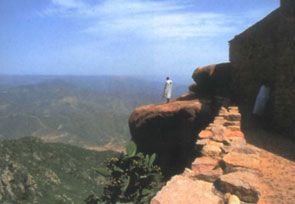 Eritrea is Africa’s youngest nation with a history as old as humanity. Its rich cultural heritage and its widely varying natural beauty, coupled with its friendly and honest people, make it a delightful place to visit. The opening in January 2000 of its first 5 star hotel, the Inter-Continental, makes it an attractive site for businesspeople, as well as tourists.
Eritrea is Africa’s youngest nation with a history as old as humanity. Its rich cultural heritage and its widely varying natural beauty, coupled with its friendly and honest people, make it a delightful place to visit. The opening in January 2000 of its first 5 star hotel, the Inter-Continental, makes it an attractive site for businesspeople, as well as tourists.
Asmara, with its old-Italian-style buildings, multiple churches and mosques, is one of the best-preserved colonial cities in Africa. The extended Red Sea coast and numerous offshore islands offer exquisite, unspoiled beaches and some of the best scuba diving sites in the world. Inland, Eritrea boasts magnificent mountain scenery, dotted with picturesque traditional villages and ancient archeological sites
Seacoast & Islands: The coast north of Massawa and between Massawa and Assab offers vast stretches of unspoiled beach front for bathing, snorkeling, and a wide range of water sports. For the more intrepid traveler, the coastal plain offers an unusual habitat for humans and for wildlife.
The many offshore islands of the Dahlak Archipelago and those near Assab have some of the best scuba diving sites in the world, from the pristine reefs of Dissei, Dur Gaam and Madote to the numerous underwater shipwrecks from all periods of Eritrean history. Sport fishing is also popular- and usually rewarding.
The largest of the islands, Dahlak Kebir, offers a modern air-conditioned hotel and opportunities to visit Afar fishing villages or ancient Turkish and Islamic ruins after an afternoon safari to catch sight of whales, humpback dolphins, the endangered dugong or one of five turtle species found in Eritrean waters.
Scenic Lands: Once back at the coast, a visitor can savor the exotic tastes of Massawa, steeped in trading history, or take a camel ride across the desert sands. Rising from sea level toward Asmara, the traveler passes the lush forests of the plains and hills of Semenawi Bahri.
A train ride up the escarpment offers stunning views as it chugs up the two-kilometer rise, crossing sheer ravines and darting in and out of sinuous solid-rock tunnels. On the other hand, going by car offers the chance to stop at Eritrea’s famous mosques and medieval monasteries or to browse a colorful village bazaar.
At 2,000 meters, the visitor reaches the cool mountain highlands, pleasant at any time of year. Along the center of the country are the gnarled mountain ranges that divide Eritrea from Ethiopia and frame the country’s bread basket. To the west are the fertile lowlands whose undulating savannah stretches to semi-desert plains of Sudan.
Along the way are the bustling market towns of Keren, Agordat, Barentu and Tessenei where Eritrea’s diverse cultures mix and mingle unselfconsciously and where it is common for a visitor to be invited into local homes as an honored guest.
Cultural & Historical tours: With more than 20,000 identified sites and many more likely, Eritrea has the highest density of ancient archeological sites in Africa outside the Nile Valley. The main sites are at Adulis on the seacoast and inland around Asmara and at Qohaito, Keskese, Tekhond’e, Metera and Der’a. Highly promising new excavations are also underway elsewhere.
Sites from the early Islamic and Turkish periods are to be found in and around Massawa and Dahlak Kebir. On the latter, there is a 10th -15th century necropolis with over 800 tombs that carry Qufic (ancient Arabic) inscriptions and 365 cisterns carved from coral limestone (one for each day of the year to accommodate the arid climate, according to islands lore).
Numerous Italian-period buildings, many in excellent condition and exhibiting a wide range of styles, can be viewed in Asmara, Keren, Dekamare and elsewhere. On a brief walking tour of the capital, one can see fine examples of Art Deco, International cubist, Expressionist, Functionalist, Futurist, Rationalist and Neoclassical architecture.
Sites associated with the war for independence are also plentiful, notably in Nakfa and northern Sahel, but also in and around most Eritrean towns and cities. The island of Naqura, near Dahlak Kebir, was the location for a brutal Italian prison colony (and mass burial ground), later used by Ethiopia to hold and torture members of the national resistance.
Other opportunities: Eritrea offers a range of options for the enterprising traveler, from urban exploration of its diverse cultures, distinctive foods and high quality but inexpensive crafts to wildlife safaris and eco-tours, hiking and bicycling excursions or relaxing soaks in the coastal mineral springs.
There are more than 400 hotels and pensions and 300 restaurants and cafes registered with the Ministry of Tourism. Numerous private travel agencies also operate offices in Asmara and other towns and cities to assist visitors.
